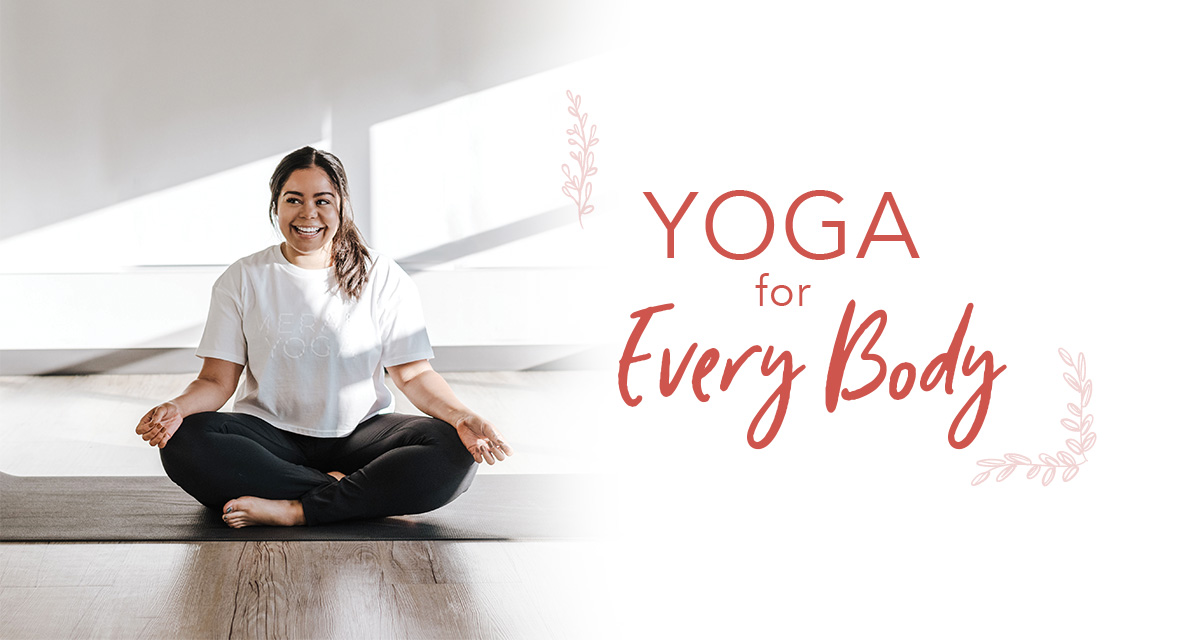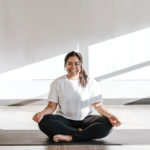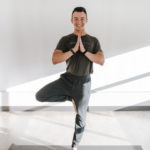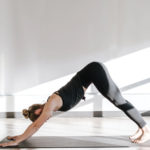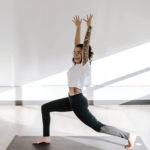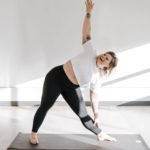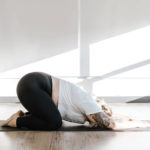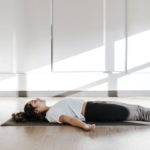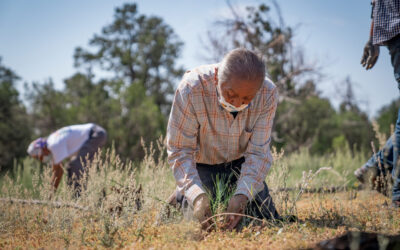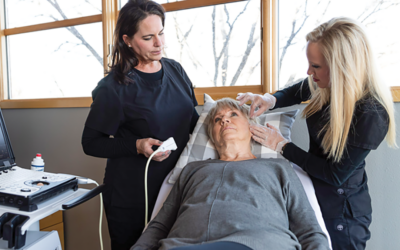By Kristin Owens
You probably knew yoga improves balance and flexibility (cue the Warrior pose), but yoga can also help manage pain, counteract stress and anxiety, and curb chronic illness symptoms. Many find they sleep better at night after a morning yoga class. Through practice, even nonathletic types can gain strength and achieve a level of fitness.
And best of all, yoga is accommodating to all body shapes, ages and motivations.
Yet studies show only one out of seven U.S. adults has taken a yoga class (National Institute of Health, 2017). For those suspicious of namaste-ing, let’s answer some basic questions and get you motivated to hit the mat.

Downward-facing dog pose. Photo by Peach Street Photo Co.
What is it, really?
Yoga isn’t just balancing on one foot while wearing the latest Lululemon. It’s a practice using breathing and postures to promote well-being, for both body and mind. Classes usually run an hour and welcome all levels of experience. Andrea Crowl, owner of Loveland’s Community Yoga Studio, offers a yoga basics class which covers the fundamentals and demystifies the mystique.
“It’s really all about breathwork,” she says. “Not crazy poses.”
Training the body to manipulate your breath rate and depth can help alleviate stress and anxiety, she says.
Another misconception is that yoga is a high-cardio workout. Though taking a heated advanced vinyasa class can definitely up the heartrate, that is a secondary benefit. Physical poses strengthen underutilized muscles. Holding poses for varying lengths of time enhances alignment. Balancing poses promotes stability.
Yoga is work. Julia Lynne, a private yoga teacher in Windsor, says with a laugh, “Yoga isn’t just the lotus pose–the epitome of a wellness image–it’s a lot of focus.” Which many of us can use in our post-holiday-technology-stress-induced pandemic days.
Do I have to chant?
No. Though chanting (repetition of a word or phrase) deepens concentration and clears the mind, it isn’t standard in most classes. But mindfulness, tuning out negative thoughts and focusing on the breath are all used in practically all classes. Lynne actively pushes back against the mysticism, which can be a turn off for new students. “Zen doesn’t just happen,” she says, “and sometimes it never does.” Rachel Butts, Meraki Yoga co-owner, agrees, “We don’t push a big Buddha on the wall.”
Those poses look hard.
Studios offer props–bolsters, blocks, and straps–which can benefit stability and help with alignment. Crowl says teachers help meet students where they’re at physically. “It’s not a ‘less-than’ to modify for physical needs,” Crowl says. “Modifications only enhance your practice.”
Will people look like me in the studio?
Lynne admits students can be intimidated before they even step on the mat because of the media. “Physical expectations reinforced by celebrities, rock stars and influencers don’t help,” she says.
But you can get rid of the preconceived stereotypes: athletic young sorts with 5 percent BMIs, CrossFit instructors, underwear models…it turns out the yoga studio is an inclusive, welcoming community for anyone willing to wear stretchy pants and bend over.
Focus is what is important
However, practicing yogis share a lot in common; they recognize the importance of arriving to the mat. For 60 minutes they can leave stresses (and stressors) behind and concentrate on themselves. It’s all about focus. Students cannot arrive late or leave class early. Cell phones are not allowed.
“By taking away distractions, students focus on why they’re there,” Butts says. “We want our students to feel amazing and leave with their day changed.”
Virtual classes are fine for folks who can’t squeeze in a commute to a studio, but there is an argument to be made for in-person classes. You meet others with similar goals. Student Raina Benford agrees, “It’s a welcoming environment that really feels like a community. Teachers greet you and know your name.”
But can I do it?
Anyone can do yoga. Generally, yoga studios are accessible to everyone, no matter the skill level, size or age. Teachers can help you adapt poses and modify routines. Have a problem with balance? Use a chair. Not able to plank on your toes? Bring it down to your knees. Need to take a pause? Head into Child’s pose to reset. When in doubt, ask your instructor for help. That’s why they’re there.
Another yoga misunderstanding: Students often believe they have to be great at it. Butts reminds us, “Everyone starts somewhere, it’s really not about an end goal. Show up and do the work.”
That’s why yoga is called a practice. “The idea of no-pain no-gain western exercise philosophy is a myth itself,” Lynne says. “Basically, if you’re making a scrunched face in class, there’s something wrong.” Yoga shouldn’t hurt you or cause distress. If it does, modify the pose.
Even with his athletic background, student Sebastian Atienza says yoga has increased his flexibility and balance. As a 25-year-old, he’s active with both weight training and running. Still, with yoga, “it’s powerful to see how strong your body is,” he says. He also enjoys the community aspect and interacting with other students.
Lauren Clay, 30, from Fort Collins, credits yoga for, “a greater relationship with my body and spiritual self.” She started practicing while in addiction recovery. “Yoga is definitely a healing tool.” She enjoys the structured routines of Hot 60 and heated Vinyasa 2 classes, allowing her to tune out and just follow. If she misses class, she feels “out of balance and disconnected.”
This sounds highly anecdotal. What about the science?
It turns out yoga has some amazing science-based, no-nonsense, irrefutable benefits. Rachel Williamson, doctor of physical therapy at UCHealth Medical Center of the Rockies, shares the fascinating medical facts of yoga practice.
Basically, the brain is a neurological map of our body, Williamson says. “We need a sharp map to experience less pain. By focusing special attention to parts of our body, the brain sends more blood to them, promoting better healing and less nerve sensitivity.” Yoga poses can promote nerve gliding or flossing. Little vessels, when stretched, help lymph nodes take away toxins. By practicing yoga, you not only feel good mentally, but physically.
Also, the focus on breathing is used in hospitals all the time. “Although we don’t call it ‘yoga,’ it helps with the nervous system to change from fight-or-flight to rest-and-recover. Breathing can hijack our brains to make our nerves less sensitive,” she states. This tool can be used anywhere once learned.
How do I start?
Find a yoga studio that offers variety. Try a bunch of classes and mix it up. Do a Yin one day and a Vinyasa the next. Most studios offer a monthly membership or punch card. Buy a yoga mat, wear easy clothes…and that’s it. Arrive to class a little early, to relax on your mat and get into the mindset.
Meraki co-owner Adrienne Hoxmeier gives the perfect advice for beginners. “Approach your practice from a place of curiosity, and don’t be afraid to ask questions.” And show up–the more you practice, the more benefits you experience.
“Make the commitment to yourself to get on your mat at least twice a week,” she suggests. Your body and mind will thank you.
10 Basic Yoga Poses
- Sukhasana Easy Pose
- Vrksasana Tree
- Adho mukha svanasana Downward-facing Dog
- Anjaney asana Crescent Lunge
- Trikonasana Triangle
- Virabhadrasana II Warrior 2
- Phalakasana Plank
- Bhujangasana Cobra
- Balasana Child’s Pose
- Savasana Corpse
Terminology
Asana – physical poses and postures
Drishti – focused gaze
Pranayama – breathwork
Ujjayi – inhaling and exhaling through the nose
Flow – a series of coordinated movements
Namaste – translation: I bow to you, used as a respectful end to class
Types of Classes
Yin – usually seated, fundamental postures held for five minutes, increases flexibility and circulation
Vinyasa Flow – coordinates breath to movement in a series of more advanced poses with smooth connections, increase focus
Fusion – slow balanced choreography broken into segments, a good option to start with heated classes
Bikram – heated at 104 degrees and high humidity, think vinyasa resulting in a cleansing sweat
Kundalini – uses meditation, repetition and mantras to activate energy based at the spine

